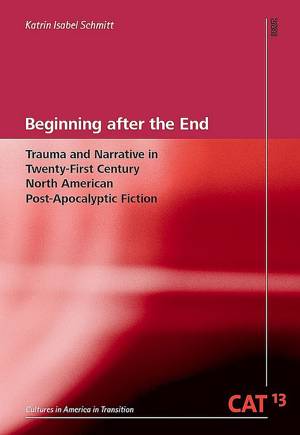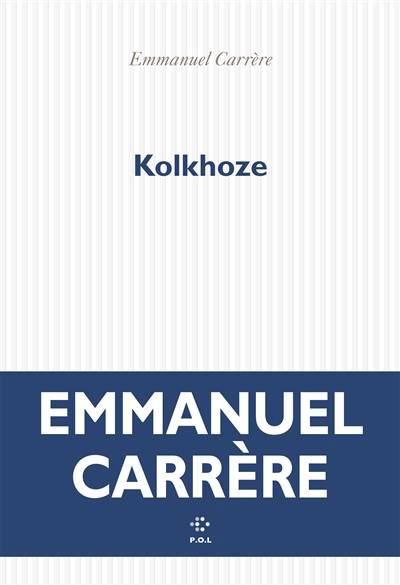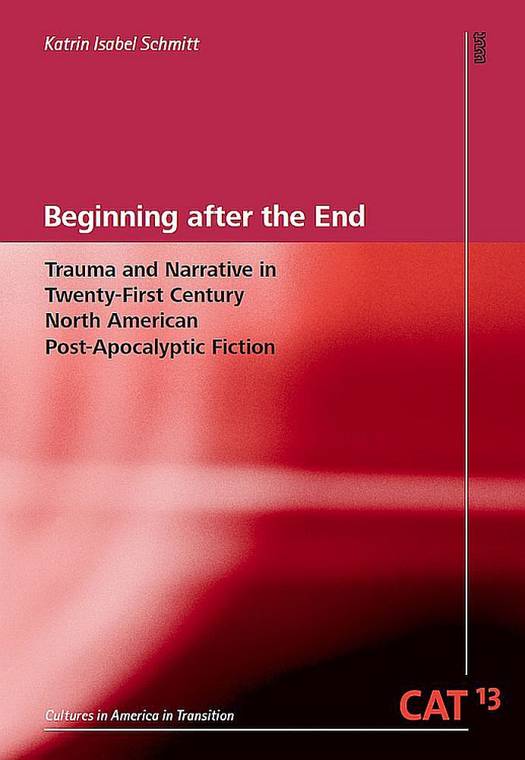
- Retrait gratuit dans votre magasin Club
- 7.000.000 titres dans notre catalogue
- Payer en toute sécurité
- Toujours un magasin près de chez vous
- Retrait gratuit dans votre magasin Club
- 7.000.0000 titres dans notre catalogue
- Payer en toute sécurité
- Toujours un magasin près de chez vous
Beginning after the End
Trauma and Narrative in Twenty-First Century North American Post-Apocalyptic Fiction
Katrin Isabel Schmitt
29,45 €
+ 58 points
Description
This book examines contemporary North American post-apocalyptic novels, proposing that post-apocalyptic literature is a form of trauma literature. The study identifies characteristic elements of the post-apocalyptic genre, focusing particularly on themes of trauma and narrative. The corpus includes Margaret Atwood's MaddAddam trilogy, Cormac McCarthy's The Road, Colson Whitehead's Zone One, Peter Heller's The Dog Stars, Nick Cole's The Old Man and the Wasteland, Edan Lepucki's California, and Emily St. John Mandel's Station Eleven.
The author develops a three-phase model of the post-apocalypse characterized by 1. Catastrophe; 2. Destruction; and 3. New Beginnings. The first phase examines the apocalyptic catastrophe as the catalyst for all-encompassing change. The second phase explores the post-apocalyptic world as a liminal space of radical transformation. The third phase analyzes depictions of potential new beginnings, where political, societal, and bioethical questions and values are renegotiated. Using this model, the study demonstrates that the phases of the post-apocalypse are closely intertwined with negotiations of trauma. The first phase represents a traumatic upheaval, the second phase portrays traumatized conditions, and the third phase presents potentially post-traumatic new beginnings.
In summary, this book provides a genre study that systematically establishes and analyzes the characteristics and variations in contemporary North American post-apocalyptic literature.
TABLE OF CONTENTS
1. Introduction 1
2. Theorizing the Post-Apocalypse 9
2.1. Post-Apocalyptic Fiction: An Overview 9
2.1.1. Apocalypse through the Ages 10
2.1.1.1. Biblical Beginnings 10
2.1.1.2. Secularization 14
2.1.1.3. Contemporary Apocalypses 18
2.1.2. Framing Post-Apocalypse 22
2.1.3. Approaching Genre 24
2.2. Trauma and Narrative in Post-Apocalyptic Fiction 27
2.2.1. Trauma Models 28
2.2.2. Trauma and Narrative 34
2.2.3. Trauma in the Three-Phase Model of the Post-Apocalypse 36
3. Worlds Falling Apart: The Apocalyptic Moment 39
3.1. Types of Catastrophes 40
3.1.1. Pandemic 42
3.1.2. Zombies 45
3.1.3. Systemic Collapse 48
3.1.4. Nuclear Destruction 50
3.1.5. Elusive Catastrophe 52
3.2. Facing the End 54
3.2.1. Pre-Apocalyptic Worlds 55
3.2.2. Reacting to the Apocalypse 59
3.2.3. Media Perspectives 62
3.3. Narrating the Apocalypse 66
3.3.1. Structure and Literary Style 66
3.3.2. Narrative Perspectives 70
3.3.3. Intertextuality and Metafiction 72
4. Negotiating the Shattered Present: Surviving in the Post-Apocalyptic World 77
4.1. Ruins and Remains 78
4.1.1. Collapsed Pre-Apocalyptic Modernity 79
4.1.2. Disrupted Space and Time 84
4.1.3. Flourishing Nature 89
4.2. Survival and Survivors 93
4.2.1. Survivor Figures 94
4.2.2. Roaming through Trauma 100
4.2.3. Language and Identity 104
4.3. Traces of the Past 109
4.3.1. Dimensions of Memory 110
4.3.2. Treasuring Objects 115
4.3.3. Documenting History 120
5. Rearranging Fragments: Post-Apocalyptic Beginnings 127
5.1. Rebuilding Society 127
5.1.1. Foundations of Post-Apocalyptic Communities 128
5.1.2. Opposing an Other 134
5.1.3. Political Institutions 139
5.2. Shaping New Beginnings 143
5.2.1. Next Generations 143
5.2.2. Preserving and Creating Art 148
5.2.3. Finding Coping Mechanisms 154
5.3. (Re)Building Frameworks 157
5
The author develops a three-phase model of the post-apocalypse characterized by 1. Catastrophe; 2. Destruction; and 3. New Beginnings. The first phase examines the apocalyptic catastrophe as the catalyst for all-encompassing change. The second phase explores the post-apocalyptic world as a liminal space of radical transformation. The third phase analyzes depictions of potential new beginnings, where political, societal, and bioethical questions and values are renegotiated. Using this model, the study demonstrates that the phases of the post-apocalypse are closely intertwined with negotiations of trauma. The first phase represents a traumatic upheaval, the second phase portrays traumatized conditions, and the third phase presents potentially post-traumatic new beginnings.
In summary, this book provides a genre study that systematically establishes and analyzes the characteristics and variations in contemporary North American post-apocalyptic literature.
TABLE OF CONTENTS
1. Introduction 1
2. Theorizing the Post-Apocalypse 9
2.1. Post-Apocalyptic Fiction: An Overview 9
2.1.1. Apocalypse through the Ages 10
2.1.1.1. Biblical Beginnings 10
2.1.1.2. Secularization 14
2.1.1.3. Contemporary Apocalypses 18
2.1.2. Framing Post-Apocalypse 22
2.1.3. Approaching Genre 24
2.2. Trauma and Narrative in Post-Apocalyptic Fiction 27
2.2.1. Trauma Models 28
2.2.2. Trauma and Narrative 34
2.2.3. Trauma in the Three-Phase Model of the Post-Apocalypse 36
3. Worlds Falling Apart: The Apocalyptic Moment 39
3.1. Types of Catastrophes 40
3.1.1. Pandemic 42
3.1.2. Zombies 45
3.1.3. Systemic Collapse 48
3.1.4. Nuclear Destruction 50
3.1.5. Elusive Catastrophe 52
3.2. Facing the End 54
3.2.1. Pre-Apocalyptic Worlds 55
3.2.2. Reacting to the Apocalypse 59
3.2.3. Media Perspectives 62
3.3. Narrating the Apocalypse 66
3.3.1. Structure and Literary Style 66
3.3.2. Narrative Perspectives 70
3.3.3. Intertextuality and Metafiction 72
4. Negotiating the Shattered Present: Surviving in the Post-Apocalyptic World 77
4.1. Ruins and Remains 78
4.1.1. Collapsed Pre-Apocalyptic Modernity 79
4.1.2. Disrupted Space and Time 84
4.1.3. Flourishing Nature 89
4.2. Survival and Survivors 93
4.2.1. Survivor Figures 94
4.2.2. Roaming through Trauma 100
4.2.3. Language and Identity 104
4.3. Traces of the Past 109
4.3.1. Dimensions of Memory 110
4.3.2. Treasuring Objects 115
4.3.3. Documenting History 120
5. Rearranging Fragments: Post-Apocalyptic Beginnings 127
5.1. Rebuilding Society 127
5.1.1. Foundations of Post-Apocalyptic Communities 128
5.1.2. Opposing an Other 134
5.1.3. Political Institutions 139
5.2. Shaping New Beginnings 143
5.2.1. Next Generations 143
5.2.2. Preserving and Creating Art 148
5.2.3. Finding Coping Mechanisms 154
5.3. (Re)Building Frameworks 157
5
Spécifications
Parties prenantes
- Auteur(s) :
- Editeur:
Contenu
- Nombre de pages :
- 202
- Langue:
- Anglais
- Collection :
- Tome:
- n° 13
Caractéristiques
- EAN:
- 9783989400702
- Date de parution :
- 23-06-25
- Format:
- Livre broché
- Dimensions :
- 155 mm x 14 mm
- Poids :
- 330 g

Les avis
Nous publions uniquement les avis qui respectent les conditions requises. Consultez nos conditions pour les avis.






